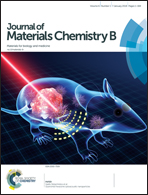Functional peptide-based nanoparticles for photodynamic therapy
Abstract
Photodynamic therapy as a non-invasive approach has obtained great research attention during the last decade. However, photodynamic therapy still suffers from low tumor selectivity and therapeutic inefficacy due to the unspecific distribution of photosensitizers in normal tissues/cells. To overcome these hurdles, functional peptides have been introduced in photodynamic therapy systems due to their advantages of functional diversity, bioactivity, high biocompatibility and biodegradability. Herein, we review various peptide-based self-assemblies or hybrid nanoparticles that have already been reported to achieve tumor tissue, cell or subcellular organelle targeted photodynamic therapy. The role of tumor microenvironments, cellular/subcellular location, and physical/chemical properties of peptide-based nanoparticles in facilitating the photodynamic therapy efficiency are discussed in-depth. The novel development of peptide-based nanoparticles described here should offer great potential to achieve better photodynamic therapy in tumors.

- This article is part of the themed collection: Recent Review Articles


 Please wait while we load your content...
Please wait while we load your content...